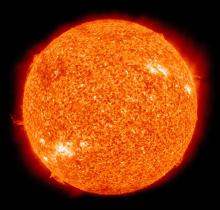Listen to today's episode of StarDate on the web the same day it airs in high-quality streaming audio without any extra ads or announcements. Choose a $8 one-month pass, or listen every day for a year for just $30.
You are here
Moon and Saturn
Jean-Dominique Cassini probably taught us more about the planet Saturn than anyone else before or since. 350 years ago this month, he discovered its second-largest moon. It’s a giant “dirty snowball” — a mixture of ice and rock.
Cassini was a leading astronomer not only of his era, but of any era. He was born in Genoa, but later became a citizen of France, where he did most of his work. He studied Jupiter, the Moon, the speed of light, and much more. But he’s best known for his observations of Saturn.
He discovered a dark “gap” in Saturn’s rings. It’s named the Cassini Division in his honor. He also discovered four moons — one of them on December 23rd, 1672. Much later, it was named for the goddess Rhea, the wife of Kronos, the Greek equivalent of Saturn.
The moon is 950 miles in diameter — less than half the size of our own moon. It orbits Saturn once every four and a half days.
Most of what we know about Rhea came from the Cassini spacecraft — named for Jean-Dominique. It flew as close as about 40 miles from the moon. It showed that Rhea is about 75 percent ice and 25 percent rock. Its surface has two giant impact basins, plus some tall ice cliffs — the surface of a moon that was discovered 350 years ago.
Saturn is easy to find tonight because it’s quite close to our moon. It looks like a bright star to the right of the Moon at nightfall. But you need a telescope to see Rhea.
Script by Damond Benningfield





